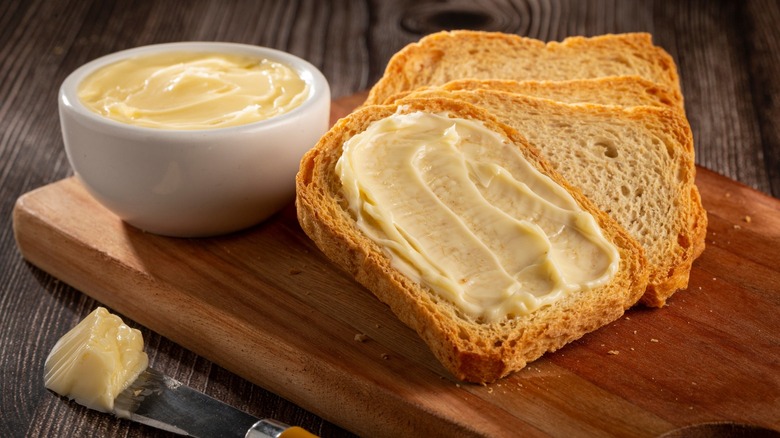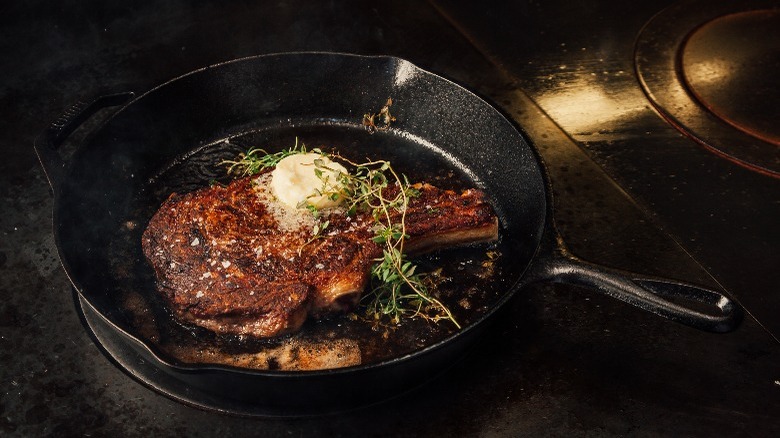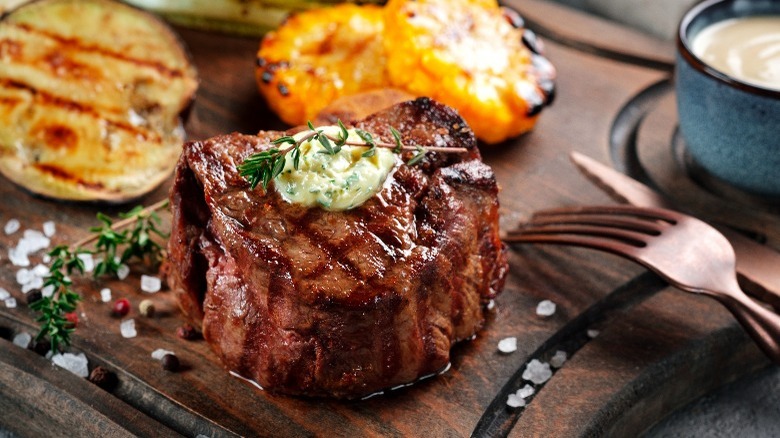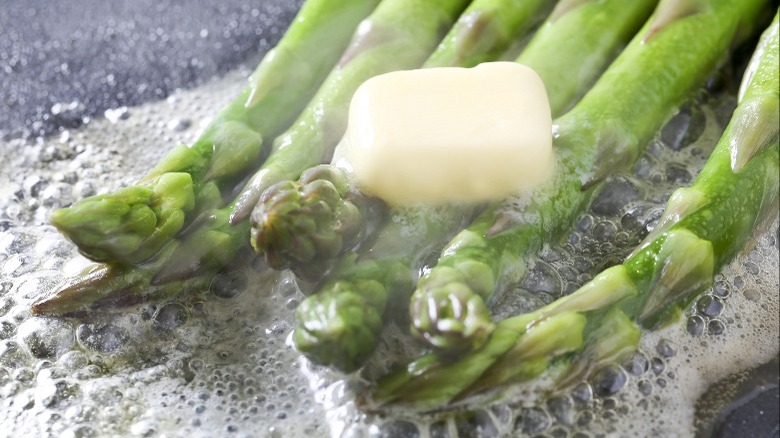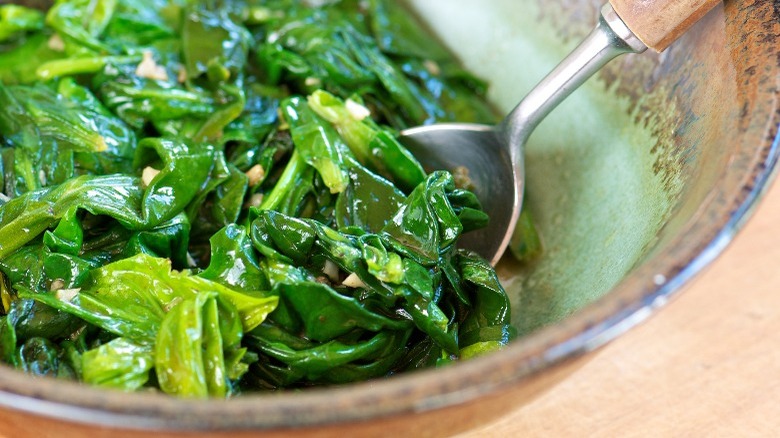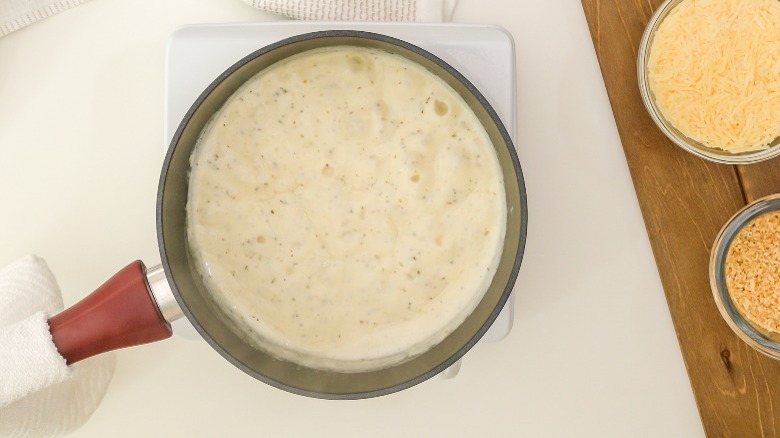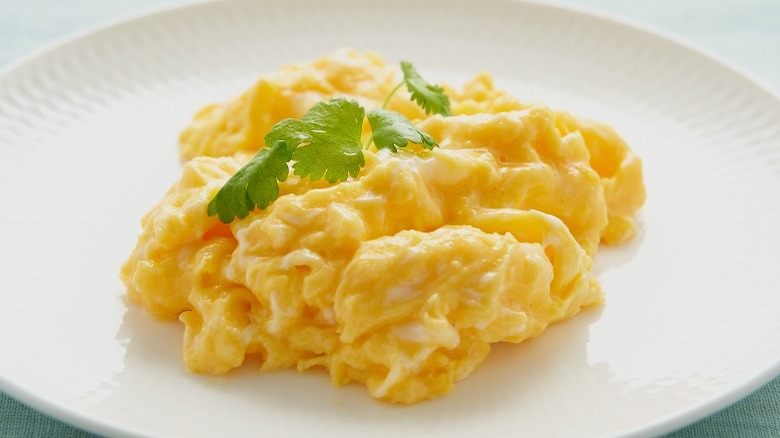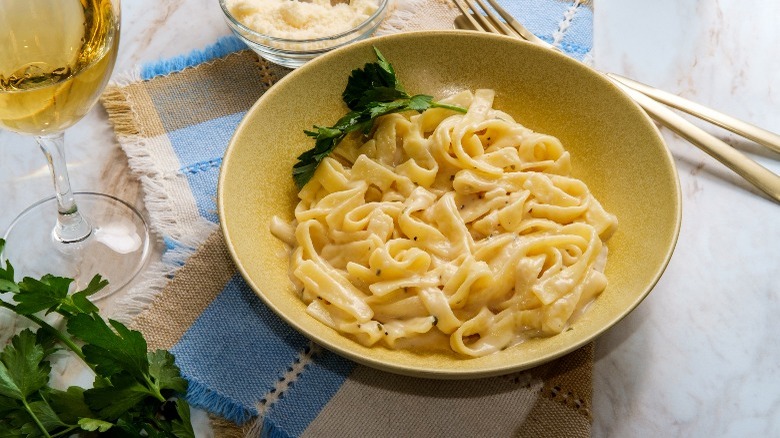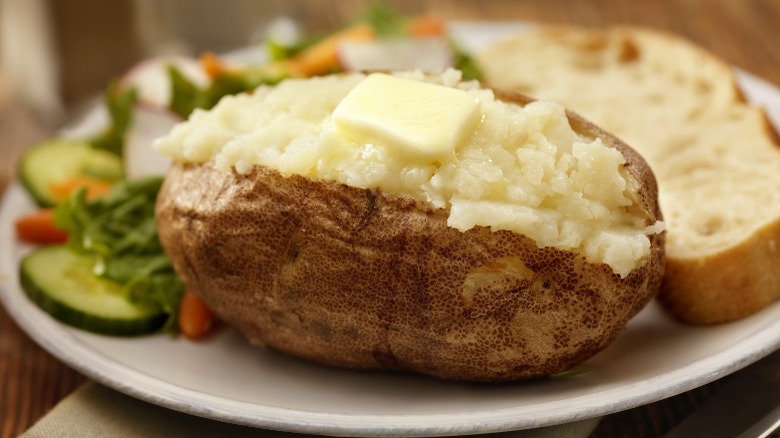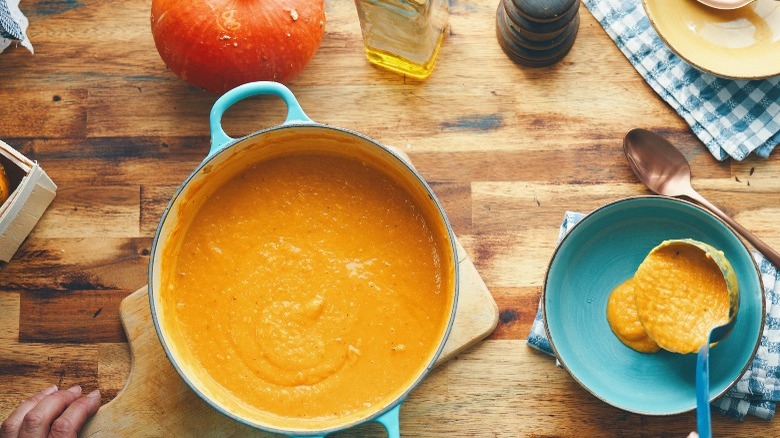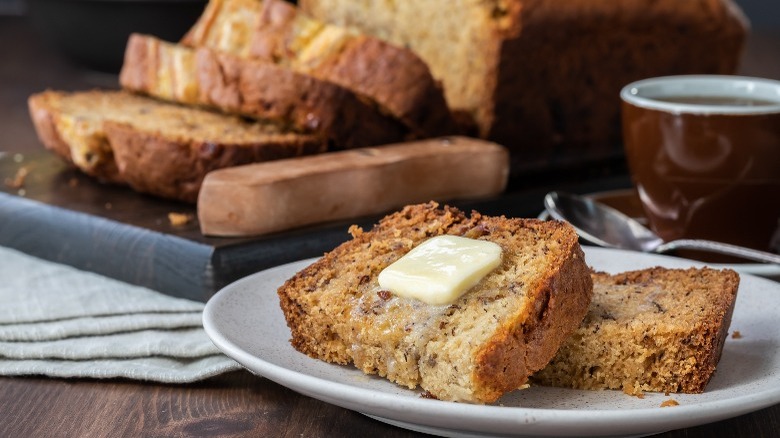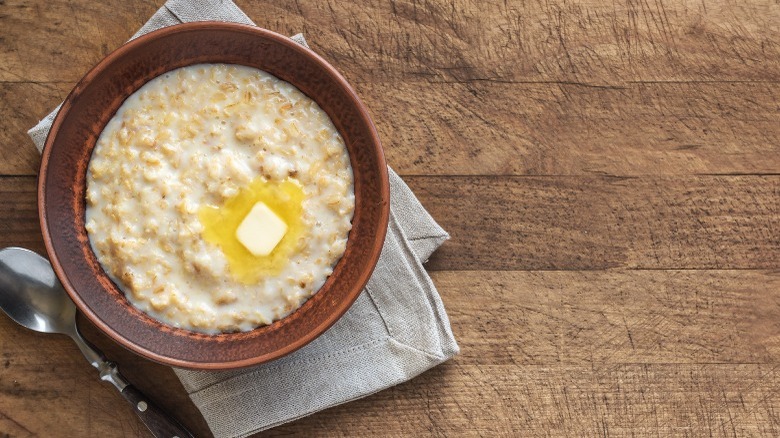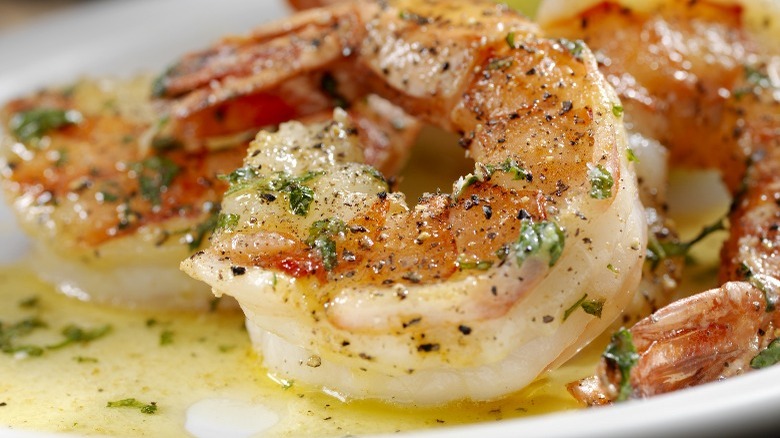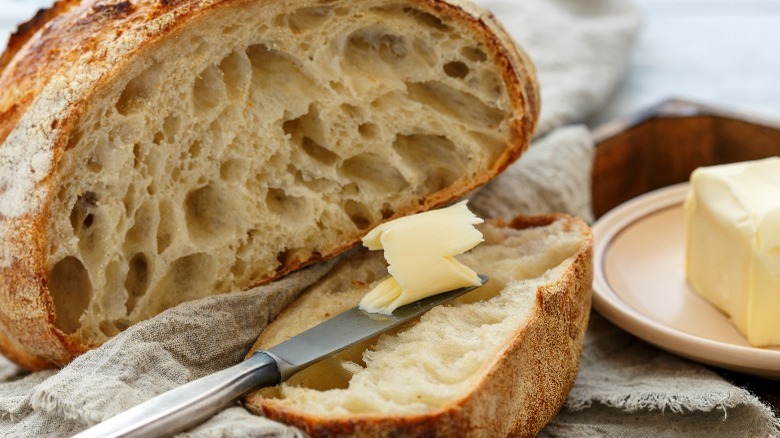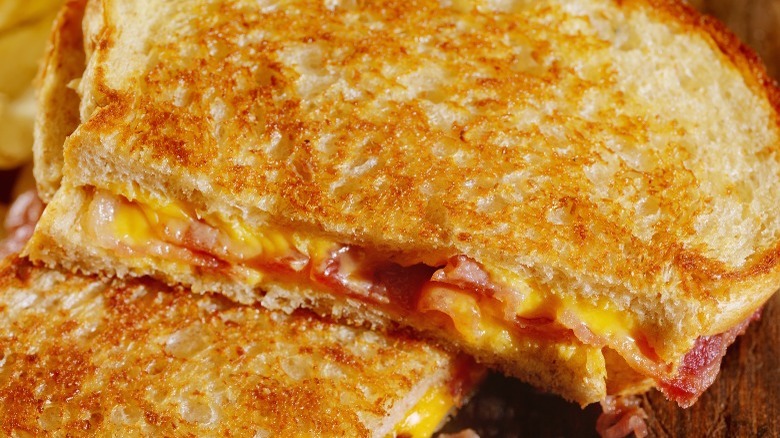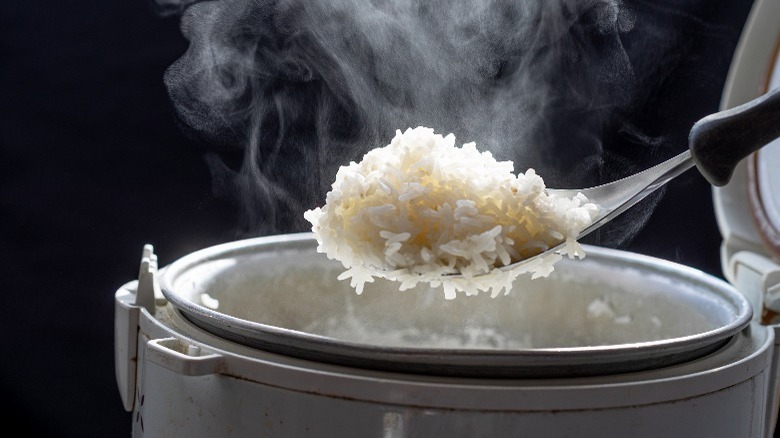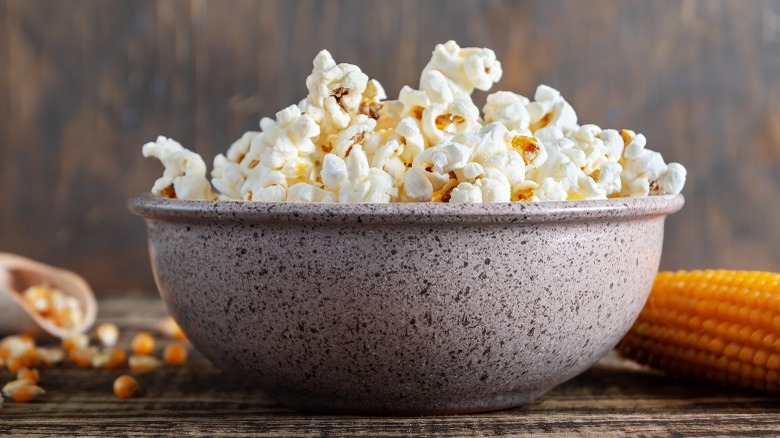16 Foods That Benefit From Salted Butter
Butter. It's more than an ingredient — it is a way of life. The rich dairy product might seem basic, but when you add it to certain foods, you're in taste bud heaven. What would toast or pancakes be without melty butter spread over the top? Can you imagine cooking or baking without having a few pale-yellow sticks ready at arm's reach?
While flavor is a top priority for most chefs, today, you'll find "healthy eating" to be just as important for others. Over the years, claims have been made that butter (made from cows' milk) can be bad for heart health. According to Healthline, when butter is consumed in moderation, it can offer several health benefits. So go ahead and eat butter, just don't overdo it.
Now that we have established that butter isn't all that bad for you when consumed in reasonable amounts, let's return to our favorite subject; flavor. When looking in the refrigerated butter section at the supermarket, you'll notice several types of butter available. The two most common, of course, are salted and unsalted.
Unsalted butter should almost always be used in baking because the lacking salt content gives it a more consistent and predictable base flavor, allowing you to have control over how much salt is added. Salted butter is excellent for finishing certain dishes, creating rich sauces, and enhancing sweet and savory foods.
Pan-seared meats
If you've ever watched Gordan Ramsey sear up a steak in a hot cast iron skillet, there's a high chance he finished it with a butter-basting technique where melted butter is spooned over the top. But that's not all he does. His secrets for making the perfect steak start with taking it out of the fridge and letting it rest. He then adds oil to a hot pan and generously seasons the beef.
Once Ramsey adds the steak to the skillet, he turns the steak every minute to allow for even cooking on each side. Some sprigs of thyme, a clove of garlic, and a few knobs of butter help transform flavor without worrying about the butter burning. The oil sears the steak, and the butter enhances the flavor.
If you have big plans for a steak dinner but run out of charcoal or propane gas, don't fret — a pan-seared, butter-basted steak is fantastic; you won't even miss the dancing flames. Some say unsalted is a better option as it has a higher smoke point and won't burn as quickly. We say salted butter adds that extra touch of savory richness that boosts the flavor of the steak like no other.
Grilled meats
Luckily, butter basting doesn't have to stop at your stove, thanks to this simple faux butter basting technique. Instead of infusing your favorite beefy cut by drowning it in a butter-filled pan, drizzle it over your steak once it comes off the scorching grill.
Slowly melt a few tablespoons of butter in a pan, and add fresh thyme and a glove of garlic. Once your steak comes off the grill, drizzle the herbed butter over the top. For even more flavor, consider slicing the beef steak-frites-style beef, then drizzling your butter. This will give an additional covering of flavor, even on the sliced sides.
Another simple way to infuse your grilled meats with butter is to add a cold tablespoon over the top before serving the steak and watch as it melts over the top. Otherwise, bring a homemade compound butter a bit past room temperature, then baste the soft deliciousness over whatever grilled meat you have on the grates. This is excellent when grilling chicken, shrimp, or steak! Your guests will ooh and awe over the restaurant-worthy flavor, no doubt.
Cooked vegetables
We all love our veggies, but it's probably safe to say we love them more when they are cooked with a bit of fat. Lucky for us, health experts claim that adding fat, like salted butter, to your vegetables will help your body absorb fat-soluble vitamins (via National Health Service). Since veggies should be on your menu every night, be sure to use up a dab of salted butter next time you plan to cook them.
Cooked vegetables like carrots, parsnips, rutabaga, onions, and garlic taste lovely with the rich addition. For example, onions and garlic benefit from being cooked gently in the fat, while heartier vegetables like rutabaga and carrots do better with being finished with a bit of melty butter. That's because onion and garlic can soften quickly, so you don't have to worry so much about burning butter. However, carrots, parsnips, and rutabaga typically need longer cooking times, so finishing them with a drizzle is typically the way to go.
Leafy greens
There's another type of vegetable that pretty much carries its own category — leafy greens. We're talking spinach, kale, collard greens, and Swiss chard. While most of us buy bags of spinach and kale to add to our morning smoothies, you'd be surprised to know how easily they go into other meals.
Anytime you make a baked pasta meal, throw a few handfuls of spinach into the red sauce before adding your pasta. It breaks down so small and adds nutritional value. Other places you can hide Swiss chard, mustard greens, and beet greens are egg rolls, sauces, soups, and stews.
If "hiding" your veggies isn't something you necessarily need to do to help your family eat healthy, grab the butter. We don't want you to drown your greens in butter, but we do recommend you add butter to provide the flavor enhancement it needs.
Salted butter, in particular, will help bring on better flavor for the more mellow greens but also help compliment the bolder or more bitter-tasting greens like mustard greens and rapini.
Rich sauces
Rich sauces wouldn't be the same without the addition of salted butter. Adding fat to these sauces carries important responsibilities for structure and flavor. One of the easiest ways to create a delicious sauce is by using the meat drippings and brown bits your pan offers and making a pan sauce. We're talking about that crusty juicy stuff left in your pan after cooking chicken or steak. While it might look like a burnt mess to novice eyes, trust us when we say you're looking at the start of a restaurant-worthy pan sauce.
What comes next is the addition of red or white wine or stock. Once added to the pan, you'll gently scrape all that goodness from the bottom with a wooden spoon or spatula. The steam lifts all those stuck bits of food and adds a depth of additional flavor thanks to whatever flavorful liquid you decide to add.
Once your liquid has reduced, you'll want to add a few pieces of cold salted butter. Not only will this further enhance the flavor profile of your sauce, but you'll appreciate what it does to texture more than anything. The butter, an emulsifier, will help bring on an excellent mouthfeel fit to accompany the meal you've already cooked.
Scrambled eggs
There are plenty of tips and tricks that can help amp up scrambled eggs. Some hacks seem a little out of the ordinary, like Alton Brown's addition of mayonnaise, which is meant to double down on the emulsion. You might not think mayo belongs, but if Alton Brown says it's delicious, how can we disagree until we try?
Besides mayonnaise, there are several other types of fat that lend well to the flavor and texture of hot scrambled eggs. A drizzle of olive oil brings on earthy notes, while truffle butter and bacon grease help the scrambles establish an entirely new flavor profile.
But if there is one beloved fat that reigns superior to all, we say it is salted butter. Not only do most home cooks always shave a few sticks handy, but the rich flavor you get with adding butter can't be beaten. Next time you make scrambled eggs, just remember that you only need a few things; patience, low heat, and plenty of butter!
Buttered noodles
You can't have buttered noodles without the butter, or the noodles for that matter. But there's a real difference in flavor when adding salted butter versus unsalted. Here's why.
When you make a batch of that kid-friendly favorite we call "buttered noodles," it's essential to get a few things right. For example, you always want to salt your water. This helps infuse your pasta with great flavor before it ever reaches the butter.
Plus, you'll appreciate using salty and starchy water in the mix to create a thick, emulsified sauce. Butter and water don't usually mix, but the salty starch from the pasta helps bring the two unmixable ingredients together and provide a depth of savory flavor. Between your well-salted pasta water and salted butter, you might not even need to fuss around adding salt toward the end. It all depends on how much brininess your taste buds appreciate.
Baked potatoes
Baked potatoes are best known for being drowned in butter and overstuffed with all the toppings you can imagine. Some appreciate theirs with the standard stuffers like butter, sour cream, bacon, and shredded cheese, while others keep things simple with a bit of butter and chives.
Regardless of your choice, most people reach for butter, and there's a good reason. Potatoes have a lovely earthy, fresh flavor to them all on their own, especially when baked rather than boiled, and salted butter enhances that natural flavor.
The rich fat which melts so quickly into the spud's meaty insides helps bring out the best of what the humble tuber has to offer. Sweet potatoes also stand out in flavor when salted butter is added, thanks to the sweet and salty combo we love. Next time you have sweet potatoes on the menu, don't shy away from adding gobs of salted butter. Your taste buds will surely enjoy the delicious duo.
Soups of all sorts
Soups, no matter what kind you make, love the addition of butter. When working hard on fish chowder, you typically find your way to the butter to soften aromatics before creating a roux. The saltiness in your butter will help enhance your onion and celery before the hot stock is added to the mix.
Even brothy soups like chicken noodle soup or vegetable beef barley typically call for butter to help slowly cook the veggies before adding broth. Again, the salt within your butter will do a great job of bringing out the flavors of your other ingredients and giving them a little more life when they cook down.
Add a few tablespoons of salted butter next time you plan to blitz up a smooth blender soup. Not only will the butter help bring on a more velvety texture, but the mild addition of salt will give it a nice flavor too. If you're hoping to transform your leftover brothy soup, the blender is a great place to turn to for an "almost" entirely new meal.
Sweet baked goods
You really can't beat the warm fuzzies that come with indulging in sweet baked goods that are still warm out of the oven. There's really nothing better than the melty chocolate chips dotted throughout muffins or the subtle crunch of walnuts mixed into the banana bread.
Until, of course, you add one more ingredient before devouring your sweet baked good. Salted butter smeared on a slice of zucchini bread or over a warm piece of cornbread hits the spot for so many reasons.
The sweet and salty satisfaction your brain gets, thanks to the biological cravings we instinctually crave as human beings, occurs when we add salted butter to sweet baked treats. The subtle saltiness from the rich fat melts right into muffins or quickbread, giving them an entirely new texture that is both inviting and flavorful.
Hot oatmeal
You can get that same effect when salted butter is added to hot oatmeal. Think about your favorite brown sugar and maple oatmeal bowl, often enjoyed with buttered toast. Have you ever wondered why the combination of buttered toast and that oatmeal go so well? It's that same sweet and salty effect! Another way to enjoy butter if you don't want to miss out on its trusty sidekick is by adding the toast to the bowl. After cooking your oatmeal and toasting your bread, give it a generous butter spread, then break the toast up into pieces and mix it right in. You will get a bread pudding-style oatmeal breakfast that is both delicious and satiating.
But beyond dipping that crunchy buttery bread into your bowl, or mixing pieces in, consider adding a swirl of salted butter right into the oatmeal itself. The butter will bring a gorgeously glossy richness to your bowl while providing a velvety texture you will adore.
Seafood and fish
It's no secret that fish and seafood taste incredible with the addition of salted butter, and there are plenty of ways to enjoy the pairing, depending on what you are making. If you plan on throwing a few shrimp skewers on the grill, give them a good basting of garlic butter while they cook up on the grates.
Lobster and crab are best enjoyed when cracked fresh out of the shell, then dipped in butter, but you can score an amazing dinner in other ways. Lazy seafood-style dinners typically consist of lobster, crab, shrimp, or scallops broiled in butter, dusted with Old bay then finished with a crackers topping.
Even a festive seafood boil calls for tons of butter mixed into the reserved broth to create a mouthwatering sauce that no one can resist. Next time you find fresh haddock or cod on sale, grab a slab and slowly cook it in salted garlic butter with a bit of Cajun seasoning or Old Bay. Just be sure to serve it with warm bread — you'll need it to sop up all that extra juicy stuff at the end.
Freshly baked bread
Remember that time in recent history when everyone was baking more and learning to make sourdough starters and gorgeous focaccia bread? If you were part of that social media craze, you probably remember researching tirelessly online to find the perfect banana bread to add to your recipe repertoire.
Between the comfort of enjoying warm baked goods and the extra time we finally had to take on fun activities like baking, we can't say we are mad about this trend. There is something special about turning flour and yeast into a risen dough that eventually hits the oven. Once it has spent the day rising and baking, you can finally wait for that golden brown exterior to reach. Then, you know what comes next — salted butter.
Buttered bread is predictable yet delicious every time, especially when the bread is freshly baked. You'll get notes of fresh yeast, followed by a warm, chewy texture, all combined with the richness of salted butter gobbed over each slice. It's just delightful.
Pan grilled sandwiches
Pan-grilled sandwiches love a good old butter spread before hitting the grill pan, and no other fat does the job better. Could you imagine a grilled cheese sandwich made with anything other than salted butter?
That gorgeous golden crust can only provide the perfect flavor with the addition of this churned-treat, and we have several sandwich examples that prove it. Tuna melts, and paninis always taste much better when lightly coated with salted butter along the bread's exterior.
That's because it adds a gorgeous crispy sheen along the outside (presentation matters, people) and also helps enhance the flavor, and provides a crunch factor for texture. Even quesadillas taste much better when salted butter is added to the pan. You can get away with grilling a quesadilla without butter, but the flavor enhancement, appearance, and texture are superior when salted butter is used.
White rice
White rice enhanced with buttery magic is so good you don't need much else to accompany it. Whether you are cooking up a batch of basmati or your heart only holds room for authentic fragrant jasmine rice, you'll appreciate the rich and salty flavors that come with the addition of butter.
There are a few ways to add butter to the rice. Before combining your rice and water, consider adding butter to your pan and stirring the rice until it is fully coated. Otherwise, add a tablespoon of butter to the water and cook it as usual.
Our favorite way to enjoy butter over rice is waiting until the rice has reached its fluffy potential, then placing a gob over the top and letting it melt. You'll experience a glossy texture and appearance, but most of all, you'll get to savor the delicious flavor of each bite.
Popcorn
Popcorn is one of those snacks that can take on so many flavors. It's healthy and delicious all on its own, but something in us loves the idea of coating and sprinkling the popped kernels with fabulous flavors.
If you like your sweet, caramel, and peanut butter drizzles, make all the difference. Then again, if you feel that popcorn shall remain a salty treat, the options are endless there too. A pinch of flakey salt or a sprinkling of nutritional yeast can transform your popcorn from bland to beautiful. Then there are a few less-known takes, like adding soy sauce, which lends to a more umami-tasting popcorn.
Alas, nothing compares to the simple addition of salted butter. While we don't recommend popping your kernels in butter (because you'll end up with a burnt mess), we do recommend topping your snack with butter. The salty taste and rich texture will no doubt create a mouthwatering snack. The combination of crunchy and somewhat soggy pieces will help your taste buds explore countering textures that are both pleasing and delicious.
Static Media owns and operates Tasting Table and Mashed.
